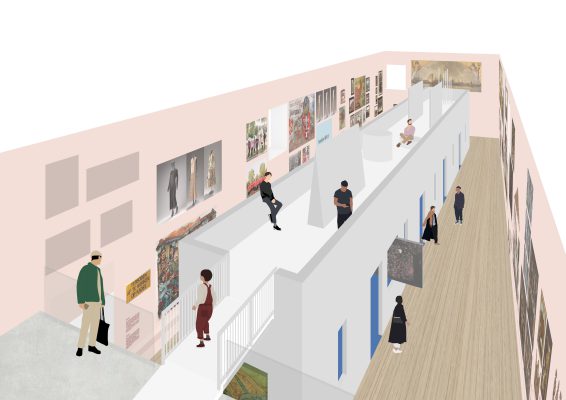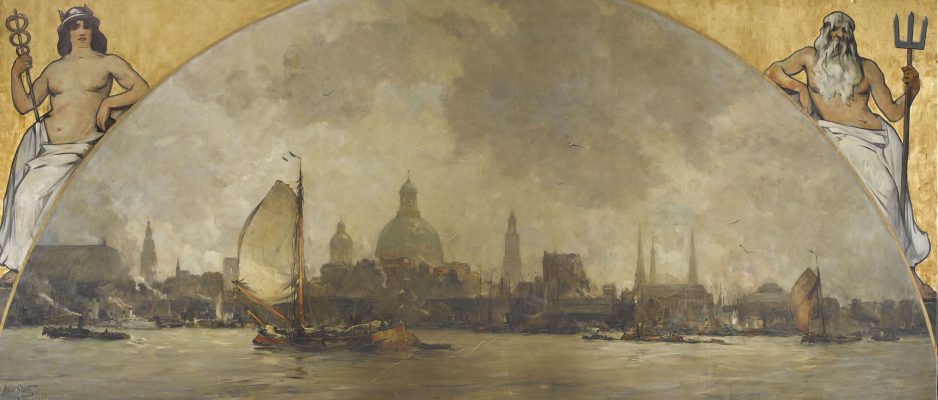For a period of 3.5 years: a permanent presentation, temporary exhibitions and programmes The Amsterdam Museum is relocating to Hermitage Amsterdam and will be open to the public there from Saturday 5 March 2022.
Amsterdam Museum’s current location, the former City Orphanage (Burgerweeshuis) at 92 Kalverstraat, is closing for major refurbishment work. From March 2022 until 2025, the Amsterdam Museum wing at the Hermitage Amsterdam will be home to the Amsterdam Museum where it will present a completely new collection including not just the traditional history of Amsterdam, but also alternative voices and lesser-known and more recent histories of the city. In addition, temporary exhibitions will give voice to residents and lovers of the city, enabling them to present ‘their’ Amsterdam. Through its display of familiar objects from its collection and new or lesser-known work, the Amsterdam Museum annexe at the Hermitage will emphasise that there is not just one single history of the city.
The Museum’s permanent chronological presentation about the histories of Amsterdam, Panorama Amsterdam: A Living History of the City’, displays familiar but also new and unfamiliar narratives about, and perspectives on Amsterdam’s past, that tell the story of how Amsterdam was established and is still developing today. In addition, there will also be smaller exhibitions, changing every six months. The courtyard will host free outdoor exhibitions and the Amsterdam Museum will also organise extensive learning and public programmes at its temporary home in the Hermitage.
Permanent collection presentation: Panorama Amsterdam: A Living History of the City
The Panorama Amsterdam: A Living History of the City collection presentation consists of over 250 objects that give visitors a multifaceted picture of Amsterdam’s numerous histories: classic icons from the city’s collection alongside new or rarely exhibited work. The presentation, designed by Studio L A, comprises two sections that interact with each other. The outer wall displays a chronological selection of stories about the city. Visitors walk through Amsterdam’s past and get a sense of how the city and its residents developed. The selection includes major, influential events, reflecting on how the city was seen at that particular time and how this is manifested in the museum’s collection. The area in the centre of the hall, which serves as a laboratory, zooms in on themes which are intrinsically linked to the city, but which in the past were left out of the main narrative about Amsterdam – either deliberately covered up or overlooked. ‘Inside’ and ‘outside’ relate to each other, creating striking and surprising intersections. Themes that are highlighted include science, trade, women’s liberation, the second world war, protests, Ajax, migration and sexual freedom.
The presentation concludes above the laboratory with a view of the main hall, a place to reflect and share experiences. Until 2025, various artists-in-residence will present their own reflections here on the stories about the city and its past. The Panorama Amsterdam presentation will serve as a testing ground. Over the coming years, in preparation for the return to its refurbished main location, the Amsterdam Museum will experiment with new perspectives on the multifaceted history of the city and of Amsterdam’s wonderful collection.
Cornelis Anthonisz (ca. 1505-1553), De Dam (Dam Square with the New Town Hall under Construction) by Johannes Lingelbach (1622-1674) and the ‘Het Snotneusje’ barrel organ, there are also recent acquisitions such as M54 by Brian Elstak (1980) and Monuments of Regents by Johannes Vermeer Prize winner Natasja Kensmil (1973) on display. Kensmil’s nine-part polyptych Monuments of Regents presents a fresh perspective on the female regents who had themselves captured on canvas in the 17th century. Only women from higher social circles could participate in the regents’ charitable work, based wealth acquired by men (their husbands). For many of them at that time, the colonial system was the foundation on which their power and wealth was built, but it also made charity possible. This uneasy contrast is highlighted by displaying Adriaen Backer’s 1683 work Female Regents of the Burgerweeshuis alongside Kensmil’s work. The laboratory relates what is not visible in the portrait, namely that the positions of all four of these women are intimately linked to the Dutch East India Company (VOC). Moreover, over the centuries, many orphan boys entrusted to their care were employed on ships belonging to the Dutch East India Company and the Dutch West India Company (WIC). This asks visitors to reflect on whether or how this affects their view of these female regents. Does it dimmish their charitable work at all?
M54 by Brian Elstak is also linked to one of the Amsterdam Museum’s classic objects, namely Portrait of the Family of Dirck Jacobsz Bas by Dirck van Santvoort from 1635. Whereas M54 tells a story on the outer wall about the contemporary relationship between the city centre and the Zuidoost district, work in the laboratory relates to the very earliest beginnings of the entire Bijlmer area: the impoldering of Bijlmermeer lake. The paterfamilias in the family portrait, Dirck Jacobsz Bas, was one of the financers of the land reclamation project and therefore one of the initial landowners. He commissioned the construction of a country home where Bijlmerweide is today. Bas was also director of the VOC and mayor of Amsterdam. This combination of involvement in colonial trade and political power was common among most of the early initiators of Dutch land reclamation.
The collection presentation Panorama Amsterdam includes several objects that have been in the Amsterdam Museum collection for a long time, but have not often left the storage facility. For example, a 700-kilo marble bust of Dora Haver (1856-1912), which was commissioned by the Vereniging voor Vrouwenkiesrecht (Women’s Suffrage Union) in 1913. It was donated to the city and displayed in the Stedelijk Museum (so it has been part of the city’s collection for over 100 years), but the director of the Stedelijk Museum had Haver’s name removed from the pedestal because he wanted to keep the issue of women’s suffrage out of the museum. In 1921 the name was restored. By then women’s suffrage was a fact.
Alongside the display of the collection, the Amsterdam Museum’s temporary accommodation in the Hermitage will also feature several temporary exhibitions, that will each run for an average of six months.
Refurbishment Kalverstraat 92
The museum complex on Kalverstraat, the former City Orphanage (Burgerweeshuis), is going to be renovated and refurbished over the next few years. In anticipation of environmental licencing, preparations for the relocation are in full swing. The museum will close its doors from Monday 28 February. During the multi-year renovation, the Amsterdam Museum will present its programmes in the Amsterdam Museum wing at the Hermitage Amsterdam.
The Amsterdam Museum’s temporary location at the Hermitage Amsterdam (Amstel 51) will be open to the public from Saturday 5 March 2022 for a minimum of 3.5 years. The presentation was designed by Studio L A design agency.

